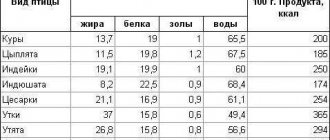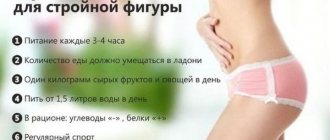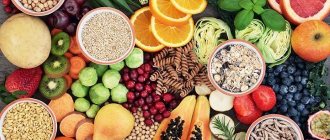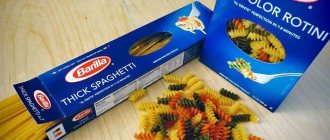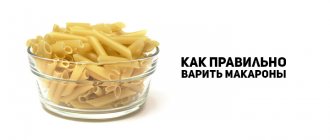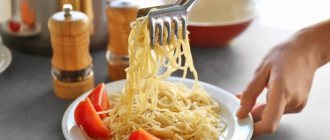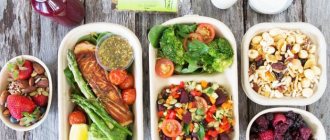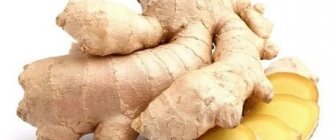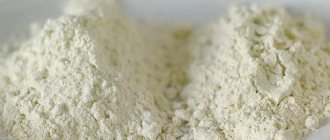Potatoes, rice, pasta: nutritionist dispels myths about harmful foods for weight loss
Nutritionist Albina Komissarova debunked the myth that when losing weight you should not eat potatoes, pasta, butter and white rice.
She also added that it is impossible to gain weight from any specific product; weight gain occurs only due to a constant violation of the diet. Komissarova wrote about this on her personal Instagram page.
“Every day I hear the phrase that certain foods can make you gain weight. Let me start with the fact that the idea that you get better from certain foods is not true in itself. They recover from overeating in general. You can eat only avocado, salmon and quinoa and gain weight, the question is in quantity,” said the nutritionist.
According to the expert, the most commonly banned foods are potatoes, pasta, white rice and butter. However, with the correct calculation of calories, as well as with proper preparation, these products will not harm the figure.
“Potatoes have a high glycemic index, but there is no point in a healthy person paying attention to it. 100 g of potatoes contains 80 kcal, which is not much. It also has high nutritional value and is an important source of potassium and vitamin C,” the nutritionist noted.
She also noted that if you eat pasta made from durum wheat, and also add vegetables and light sauces to it, there will be no harm to your figure. In addition, many people “sin” with butter because of its high calorie content, but the norm for this product is only 10 g per day, while coconut oil, which is considered dietary, contains even more calories.
“Coconut oil, which everyone eats by the tablespoon, contains a higher percentage of saturated fat. So why are we afraid of butter?” – the expert emphasized.
As for white rice, Komissarova noted that it can be eaten in moderation, provided that the diet contains enough fiber.
As OBOZREVATEL reported, Belarusian nutritionist Alla Malaykina previously told how many kilograms you can lose weight in a month without harming your health.
Source
Chemical composition and trace elements
A set of vitamins, macro- and microelements, acids determines the properties of the product and its nutritional value.
The mineral composition of the product includes:
100 g of rice satisfies the body’s daily requirement for manganese by 48%, copper by 12%, and zinc by 10.5%.
The cereal does not contain fat-soluble vitamins. But it is rich in water-soluble B vitamins (B1, B2, B5, B6) and PP.
Reference. Rice bran leads among other products in the content of thiamine (B1), pyridoxine (B6) and niacin (B3 or PP). There is more pantothenic acid (B5) only in shiitake mushrooms, chicken yolk and liver.
Potato
Raw potatoes contain the most of the following minerals and trace elements:
The main vitamin is ascorbic acid. To satisfy the daily need for vitamin C, 200-300 g of the product is enough. Potatoes also contain B vitamins, PP and choline. Yellow-fleshed tubers contain carotenoids that act as provitamin A.
Among the organic acids present in potatoes are citric, oxalic and malic.
Potatoes - benefits and harm. Description, calorie content and characteristics of potatoes
Calorie content and dietary fat, glycemic index
The calorie content and nutritional value of these products depend on several factors: variety, method of preparation. Let's compare the calorie content of potatoes and rice and other indicators of nutritional value.
Different types of rice
There are red, brown (brown), wild (black) and white rice:
The energy and nutritional value of different types of rice is presented in the table.
| Type of rice | White | Brown | Red | Wild |
| Energy value, kcal | 360-370 | 337 | 362 | 101 |
| Proteins, g | 7 | 7 | 10,5 | 16 |
| Fats, g | 1 | 2 | 2,5 | 3 |
| Carbohydrates, g | 80 | 73 | 70,5 | 79 |
| Glycemic index | 85 | 55-60 | 55 | 45-50 |
Pasta menu.
Pasta for weight loss is another product prohibited by many diets, although again there are no sufficient reasons for this. In terms of energy value, regular pasta contains 355 calories per 100 g, 12.5% protein, 1.2% fat, 73.5% carbohydrates and 4% fiber. As long as you have a balanced diet, creating a pasta-based diet is quite simple. You can have a pasta fiesta for the whole week or alternate the menu with options from other sections.
How to compare rice and noodles?
Let's look at the same table for 100g of rice and noodles:
| Contents [show] | Rice | noodles |
| calories | 101g | 157g |
| Calories from fat | 3g | 8g |
| Total fat | 0.6g | 0.7g |
| Saturated fat | 0g | 0g |
| Trans fat | 0g | 0g |
| cholesterol | 0mg | 0mg |
| Sodium | 3mg | 130mg |
| Total carbohydrates | 21g | 31g |
| Alimentary fiber | 1.8g | 2g |
| Sugars | 0.6g | 0.7g |
| Protein | 4.3g | 5.7g |
| Vitamin A | 0% | 0% |
| Vitamin C | 0% | 0% |
| calcium | 0% | 0.7% |
| Iron | 3% | 7% |
calories
Looking at these two nutrition panels, it's clear that if you judge which food is healthier based on calories, rice will come out ahead.
100 grams of rice contains the same amount of calories as 50 grams of noodles. Here, this amount of food accounts for about 175 calories.
The percentage of fat is also higher in noodles with 1% fat rice compared to 2% noodles.
However, it should be noted that some types of rice, such as fried rice, may contain more fat and calories.
Vitamins
Neither noodles nor rice are rich in vitamins and minerals. However, they both contain iron, which is an essential nutrient for the body.
Noodles contain 10% iron compared to rice's 5%.
The noodles also contain 1% calcium, which is good for bones. No rice.
Sodium
Sodium is a mineral that helps control fluid levels in the body. It also helps in nerve impulse transmission and muscle control.
However, excessive sodium intake can cause high blood pressure.
The sodium levels in the noodles are significantly higher. Carbohydrates contain 8% sodium, but rice has none.
carbohydrates
Noodles have a higher percentage of carbohydrates than rice. It is 14% compared to 12% for rice.
fiber
Fiber is good for gut health. It can lower blood sugar, lower cholesterol and reduce appetite. Rice contains 12% fiber, while noodles contain 2%.
Nutritional value of noodles
For a 1 cup (140 g) serving:
| Contents [show] | Per serving | % Daily value |
| calories | 220g | 11% |
| Calories from fat | 11g | |
| Total fat | 1g | 2% |
| Saturated fat | 0g | 1% |
| Trans fat | 0g | |
| cholesterol | 0mg | 0% |
| Sodium | 183mg | 8% |
| Total carbohydrates | 43g | 14% |
| Alimentary fiber | 3g | 10% |
| Sugars | 1g | |
| Protein | 8g | |
| Vitamin A | 0% | |
| Vitamin C | 0% | |
| calcium | 1% | |
| Iron | 10% |
Percent Daily Values are based on a 2,000 calorie diet.
Beneficial properties for the body
In moderation, rice and potatoes are beneficial for the body, and their rich composition allows them to be used for medicinal purposes.
The benefits of rice are due to its chemical composition:
Rice water has medicinal and cosmetic properties
Potato
Potato starch, like rice water, is an enveloping agent, so it is used after poisoning orally (in the form of jelly) or as an enema.
Freshly squeezed juice neutralizes the effects of acids, relieving heartburn and helps in the treatment of gastritis, gastric and duodenal ulcers. Starch lowers blood cholesterol levels.
In folk medicine, the use of potatoes is varied:
In home cosmetology, raw tubers help fight dark circles under the eyes, and masks with potato juice relieve acne.
What is healthier: rice or potatoes?
Most people consider potatoes to be a useless food and a cause of excess weight. This product contains a large amount of carbohydrates and is hardly suitable for dietary nutrition. One hundred grams of boiled potatoes contains 80 kcal, fried potatoes - 200 kcal. Rice has a low calorie content compared to potatoes - about 130 kcal, and is ideal for the diet. But in our country they still prefer to eat potatoes. Let's try to figure out what is healthier: rice or potatoes?
What are the benefits of potatoes?
Potatoes contain a large amount of amino acids, potassium, folic acid, phosphorus and PP. Young potatoes are rich in vitamin C, but their amount decreases during storage. Potato starch can reduce cholesterol levels and is useful for atherosclerosis. Due to their high potassium content, potatoes help remove excess fluid from the body. Potatoes can be consumed by people suffering from gastritis and stomach ulcers.
Potatoes are quite a high-calorie product and contain a large amount of starch. It should not be used if you are prone to obesity. However, in healthy people, this product helps normalize metabolism. With its help you can neutralize the effects of acids on the body. It is very good to eat boiled potatoes when recovering from fasting.
Under no circumstances should you eat green potatoes. Under the influence of the sun, solanine is formed in fruits, frequent use of which can lead to death. You should not eat potatoes if you have low stomach acidity, diabetes mellitus or pancreatic diseases.
How does rice affect the body?
Rice contains much more vitamins and beneficial elements than potatoes. Cereals are rich in vitamins B, E, PP, and also contain potassium, iron, iodine, selenium and phosphorus. Despite its low calorie content, rice is a fairly filling product. Rice contains lecithin, an oligosaccharide and a large number of amino acids. Rice perfectly neutralizes the effects of toxic substances that enter our body with food. Rice also contains starch, which is a source of carbohydrates.
Harm and possible contraindications for use
Potatoes and rice have a number of contraindications. Their common disadvantage is their high starch content. Its components are amylopectin and amylose - glucose chains. This makes the foods dangerous for diabetics as they can cause a spike in blood sugar.
Possible harm of rice:
The greatest danger that potatoes can pose is the toxic substance solanine. Normally, it is present in the product in small quantities, but under the influence of direct sunlight or when sprouts appear, its concentration increases. Outwardly, this manifests itself as green spots on the tubers. Solanine in a dose of 20 mg leads to mild poisoning, 200-400 mg - to death.
Fried potatoes, french fries, and chips can be cooked in low-quality oil that has high levels of carcinogens. The high calorie content of these dishes makes them dangerous for overweight people.
Pasta versus potatoes: who wins?
Carbohydrates are an important part of a complete diet. Which products are their best source can be debated at the level of national cuisines. Let's try to look at this issue from the perspective of Italy versus Russia, or, to put it simply, pasta versus potatoes.
Carbohydrates, depending on the rate of absorption, are divided into fast and slow. Fast carbohydrates are all sweets: glucose, fructose, sucrose. They cause a rise in blood sugar and insulin and quickly turn into fats. Slow carbohydrates (starches), found in pasta, potatoes, cereals, bread, do not create sugar spikes and are the highest quality and correct “fuel” for us. But besides the carbohydrates in pasta and potatoes, there are other variables that affect the body in one way or another. Therefore, we will weigh the pros and cons.
Nutritionist opinion
Among those who want to lose a couple of extra pounds in a short time, the rice mono-diet is popular. Adherents of this type of nutrition refer to the fact that when boiled, rice loses its calorie content several times, and rice porridge contains only 140 kcal, instead of 370 in dry grain.
An attractive factor is its low fat content (virtually no fat), so rice is often used by athletes during the so-called “cutting” - losing fat mass.
Reference. To avoid problems with constipation, the rice diet is combined with plenty of liquid, vegetables and fruits. Water and fiber promote intestinal contractions.
But polished grain is a source of fast carbohydrates. White rice has a high glycemic index, and weight loss on such a diet occurs only due to a decrease in total calories.
A healthier way to lose weight is to include red, brown or black rice in your diet. The high fiber content makes these cereals indispensable in the diet of overweight people.
Important! Adherents of a vegan diet should not be deluded by the high protein content, because it is incomplete - it lacks two amino acids: asparagine and glutamine. Therefore, it is recommended to combine wild rice with legumes, nuts or seeds.
As for potatoes, this product is undeservedly included in the ranks of the main enemies of a slim figure. When boiled, especially in their skins, potatoes are no more nutritious than other side dishes. The best addition to potatoes is a light vegetable salad and fresh herbs, which will balance the high starch content in the tubers.
Types of rice
There are several types of rice: white rice, red rice, brown rice, wild rice and black rice.
The most popular is white rice . Thanks to special processing, it is smoother, and its taste is superior to other types. However, grains that have been polished lose many useful elements.
Red Bhutanese rice is semi-polished, with part of the bran shell remaining on its grains. Since it is not completely polished, its cooking time is much longer than that of white rice.
Brown rice retains the greatest number of beneficial properties, since it is not peeled from the grain shell and is not processed. However, when cooking, you should take into account that its grains are much tougher, so it takes longer to cook than other types. Brown rice needs to be soaked for several hours before cooking.
Black rice is often confused with wild rice because of its color, although their properties are completely different. Black rice has a sweetish taste and helps with digestive disorders. Wild rice has a diuretic property, reduces fever and helps quench thirst. Wild rice grains are thinner and elongated, while black rice is more rounded.
What to choose
If there is a choice between potatoes and rice cereals, then the product that is more natural should be given attention. Boiled potatoes in moderate quantities will not cause health problems and are perfect for dietary nutrition, but fried potatoes often lead to liver and stomach diseases.
Rice is also an equally healthy product, so from time to time it is recommended to consume dishes using it. But again: it’s all a matter of habits and tastes, so everyone decides for themselves what they will eat for lunch, dinner or breakfast today!
Source
Potato menu
Most diets exclude certain foods as a source of fat and extra pounds. The number one enemy, according to some, is potatoes. However, there is a lot to be said in favor of potatoes: 100 g of them contain 19 g of complex carbohydrates, 30 mg of magnesium, 380 mg of potassium, 1 mg of iron and only 90 calories.
Due to their low cellulose content, potatoes are an easily digestible product that also gives you a feeling of fullness. It is easy to digest and does not raise your body temperature, making it an ideal vegetable for dinner. So why do potatoes have such a bad reputation?
Because we are used to serving it with fats in the form of butter, vegetable oil and sour cream. If you eat potatoes without such harmful additions, there is nothing wrong with them.

